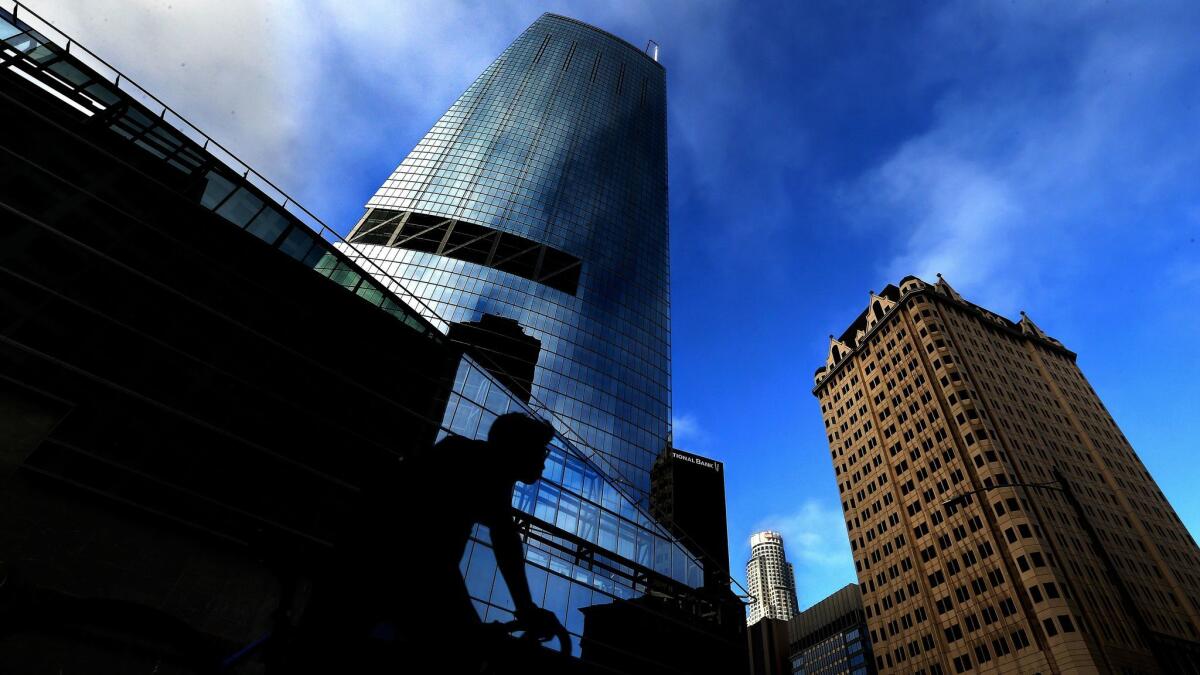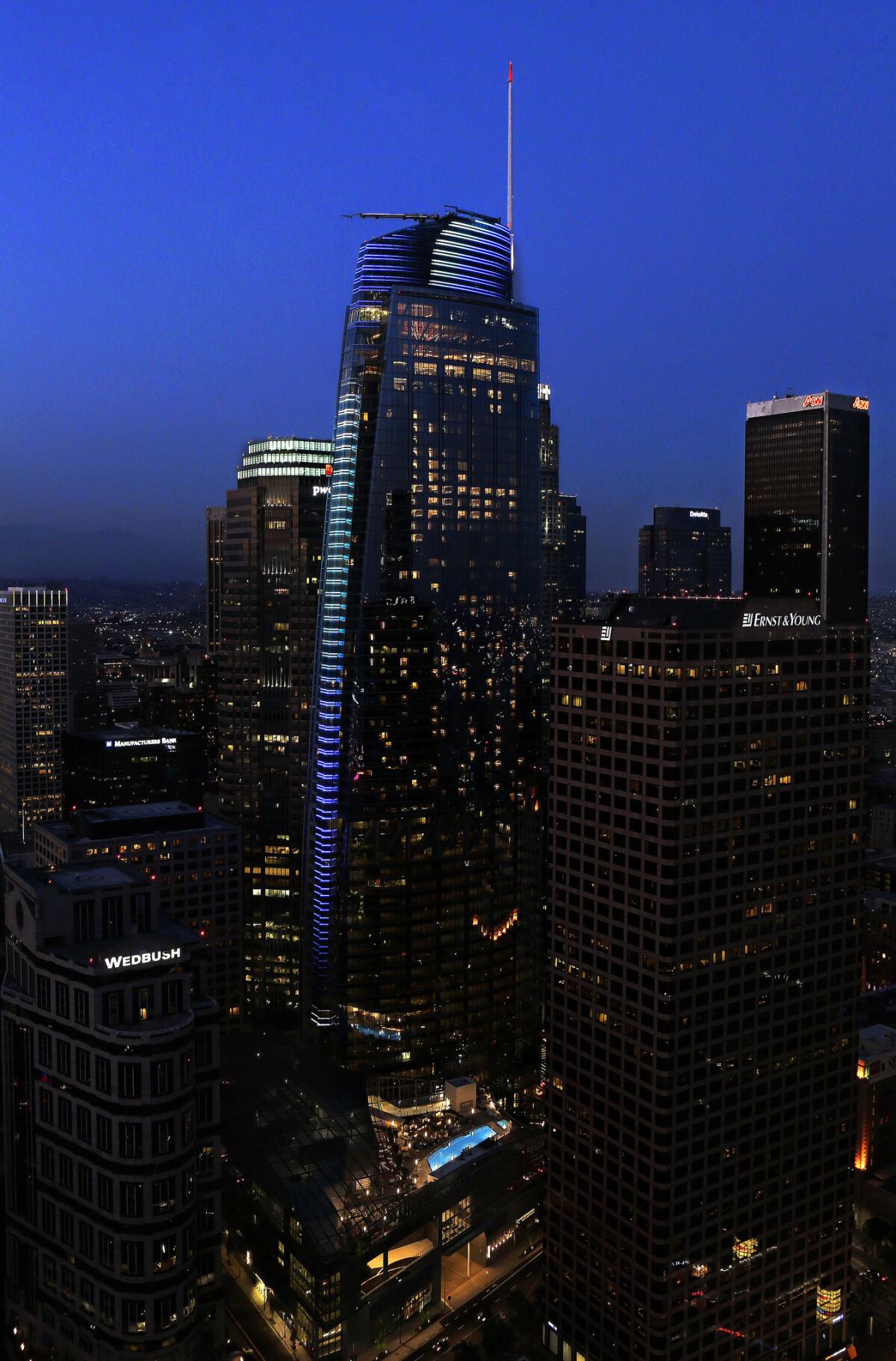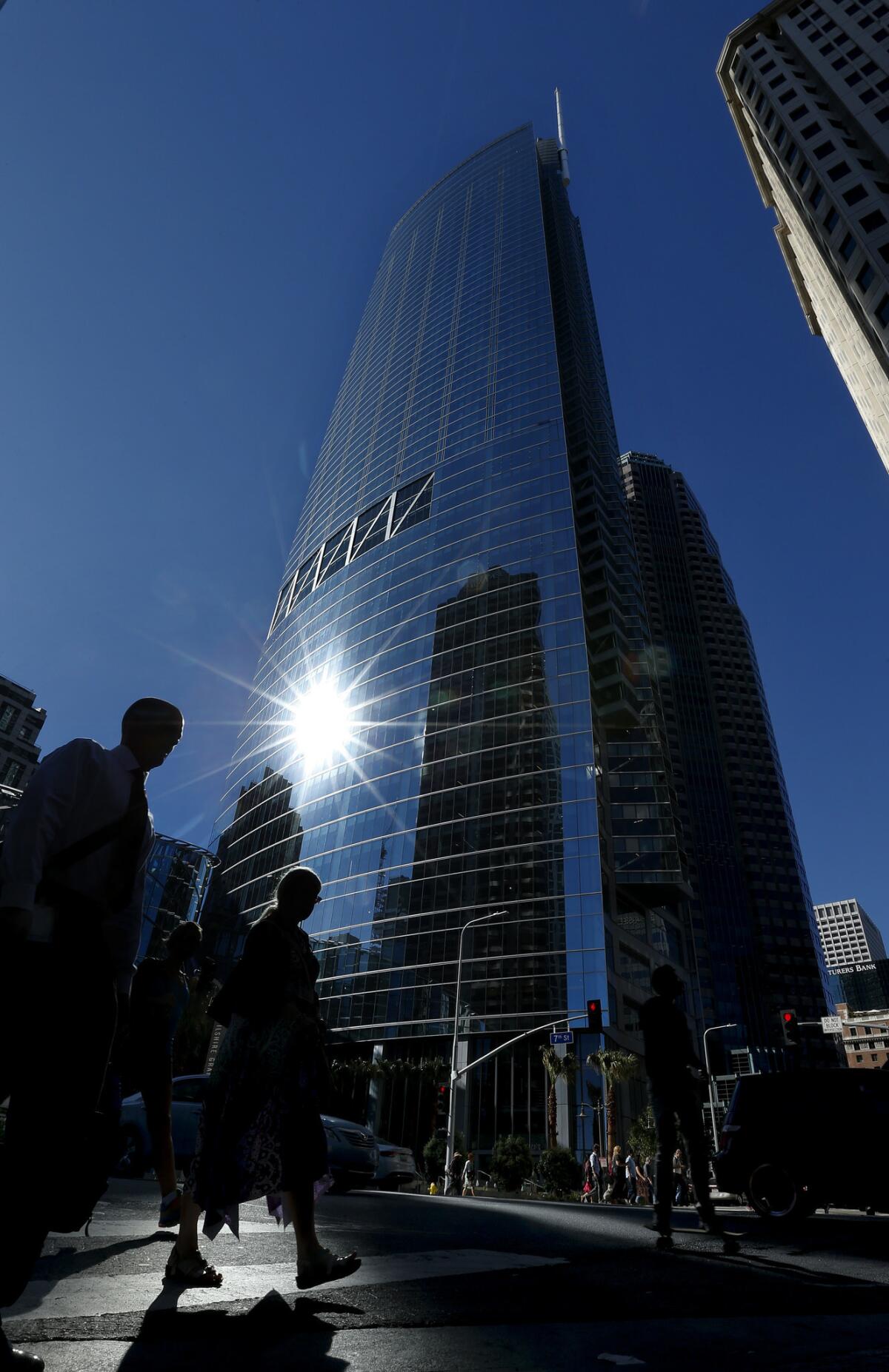Review: Wilshire Grand Center, the new tallest building in L.A. and a schmoozer in the skyline

- Share via
Here’s the long and short of it: Los Angeles still hasn’t produced a skyscraper that qualifies as a great work of architecture.
The Wilshire Grand Center opened Friday as the tallest building in the city and the highest west of the Mississippi River, if only thanks to its spire. Holding meeting rooms and 365,000 square feet of class A office space on its lower floors, a 900-room InterContinental Hotel on its upper ones and a collection of bars and restaurants at the top, it reaches 73 stories and 1,100 feet, edging out the 1990 U.S. Bank Tower a few blocks away.
Chris Martin, chief executive of the century-old L.A. firm AC Martin Partners, which designed the tower, told me that what sets it apart, along with its height, is that it’s not restricted to a white-collar crowd. Because earlier L.A. skyscrapers (including the U.S. Bank Tower) were built to hold only offices, the general public never got to enjoy the views from the top, he said.
“And you can do all kinds of little cute things, like put a slide on it” — this was a reference to the U.S. Bank Tower’s recent redesign of its top floors to bring in that wider public, a remodel that included adding a transparent slide to the outside of the building — “but that doesn’t change the fact that it wasn’t originally designed for the public. We built a tower for the public.”
This was an intriguing argument: the Wilshire Grand, a $1.35-billion skyscraper designed for Yang Ho Cho, chairman of Korean Air, which owns the building, as populist landmark for an increasingly vertical Los Angeles.

The fact that there could be an active rivalry between two skyscrapers alone says a good deal about how much the city and its sense of itself is in flux; one historic drag on our tower architecture has been the polycentric nature of Los Angeles, the fact that we have many tentative skylines (in Century City, along Wilshire Boulevard and downtown) instead of a single mature one. This has prevented the competition among neighboring towers for attention and acclaim that has sharpened the high-rise architecture of New York, Chicago and other cities. Many of our most architecturally significant towers, 450-foot-high City Hall chief among them, are meanwhile too short to really count as skyscrapers.
If nothing else, Martin’s pitch suggested that he has a keen understanding of the strengths and weaknesses of the building, which occupies a trapezoid-shaped piece of land bordered by Wilshire Boulevard and 7th, Figueroa and Francisco streets and overlooking the 110 Freeway.
Designed primarily by his cousin David Martin, along with their colleague Tammy Jow, a senior designer at AC Martin, the Wilshire Grand is not going to win any awards for architectural refinement. As an object in the skyline it’s a dog’s breakfast, a tower that compromises the interest in sleekness suggested by its mirrored-glass skin with over-articulated elevations on all four sides and an oddly inconsistent fetish for expressed structure.
Because AC Martin convinced the city to waive a longstanding rule that every tall building in Los Angeles must have a large helipad on its roof to accommodate fire-fighting crews, a rule that has now been retired for good, the Wilshire Grand does manage to avoid the generic, buzz-cut plainness that marks so many L.A. skyscrapers. Instead, a curving glass sail crowns the building like a 21st century pediment, hiding the elevator and window-washing equipment.
A small concrete pad is in fact hidden away atop the tower, I was surprised to discover on a recent tour. Officially it’s a “tactical landing platform” where a helicopter could touch down. It’s modest enough, though, to nearly disappear from a distance.
Back on terra firma the Wilshire Grand meets the ground awkwardly. The gap between the base of the tower and a squat, semi-attached podium holding stacked ballrooms and meeting rooms is bridged by a sweeping lattice of steel and glass that suggests not uplift but fallen mass, a flying carpet that failed to fly and is now wedged heavily above the lobby. A highlight of the ground-level spaces — a highlight of the whole complex, to be honest — is a rainbow-colored, wall-mounted installation by the Korean artist Do Ho Suh.
A plaza with a fountain and palm trees opens in the direction of the Metro subway station across Figueroa, but on its other three sides the Wilshire Grand seems determined to keep the urban realm (and pedestrians in particular) at bay.

Nor is its height alone enough to allow the tower to really stand out. Its highest occupied floor is lower than the same space over at the 1,018-foot-high U.S. Bank Tower; only because the Council on Tall Buildings and Urban Habitat, the arbiter of such things, has determined that spires — though not “antennae, signage, flag poles or other functional-technical equipment” — count toward what it calls the “architectural top” of a building does the Wilshire Grand rank as tallest in the city.
More to the point: In national and especially global terms 1,100 feet is a middling number. The tallest building in the world, Dubai’s
But a crowd-pleaser? Maybe. A kind of whiz-bang appeal, some combination of flash, mass and scale? A way to take advantage — to Martin’s point — of how few L.A. skyscrapers give over their top floors to restaurants, bars and other spaces open to the public?
That’s an idea that might have some legs. For all its aesthetic wobbles, its unresolved quality as a work of architecture, the tower has a certain guileless charisma; it tries so hard to please that it winds up being tough to dislike.
The formal touchstones the architects say inspired them — Half Dome for the curving edge of the sail, airplane design for the transparent vertical wings that extend past the edge of each side of the tower — are familiar ones for any Californian, as opposed to the references to Foucault or
The most fascinating aspect of his argument is that on its face it seems plainly counterintuitive. The tower — unlike so many others going up across the country and the world these days — is not a residential building; the general public’s access to it won’t continue 24 hours a day.
On top of that, we’ve tended to think of low-to-the-ground architecture as the most genuinely Los Angeles architecture of all, the most connected to the popular will and everyman aspiration: the small house with connected garden, the single-story donut shop with a two-story-tall concrete donut on its roof, the bungalow court, the strip mall with a world-class sushi bar squeezed in next to the laundromat.
SIGN UP for the free Essential Arts & Culture newsletter »
We have been wary in Los Angeles of the tall building and everything it represents: a creeping Manhattanization, to borrow an evergreen term in Southern California development fights, a fear that we’ll be sealed inside glass towers, cut off from the benign climate so many of us moved here to take advantage of. L.A. first put a measure on the ballot to limit building heights more than a century ago. It has spent the intervening decades feeling ambivalent about whether skyscrapers really belong here.
Though it’s happening slowly, that ambivalence is fading. The neighborhoods that younger Angelenos are increasingly pouring into, downtown and Koreatown in particular, include L.A.’s most vertical. A steady supply of foreign cash looking for a safe haven has begun to thicken the skyline.
When slow-growth advocates put controversial Measure S on the ballot in March, one of their chief arguments was that dense, increasingly vertical development was overwhelming neighborhoods across the city. The measure was routed, barely mustering three votes out of 10. The idea that the authentic Los Angeles is the horizontal one is looking increasingly outdated, or maybe just incomplete.
At least until another tower passes it in height, the Wilshire Grand will stand as the imperfect emblem, the boisterous marker in the skyline, for this new city.
Twitter: @HawthorneLAT
MORE ARCHITECTURE STORIES:
How New York's rising trend of 'supertall' towers looks from the 92nd floor
Frank Lloyd Wright at 150: Why his Los Angeles houses deserve a closer look
The biggest entertainment stories
Get our big stories about Hollywood, film, television, music, arts, culture and more right in your inbox as soon as they publish.
You may occasionally receive promotional content from the Los Angeles Times.








